In an earlier ITSM.tools article called “The Post-COVID State of Well-being in ITSM – the Good, the Bad, and Maybe the Ugly” I promised to write another article. This time to look at the main correlations between the eight questions covered in our 2020 “well-being in IT” survey. Now, after comparing 28 question “pairs,” and just in time for the “second-wave” lockdown in the UK and elsewhere, I can share what I found in terms of what’s causing the well-being issues in IT service management (ITSM).
First though, a quick reminder of the questions.
The 8 well-being-in-IT survey questions
The survey asked the following eight questions:
- Do you think working in corporate IT will get harder over the next three years?
- Do you feel your personal efforts, and your value to the business, are sufficiently recognized by management?
- Did you feel your personal efforts were sufficiently recognized by management during the COVID-19 crisis?
- Do you feel that working in IT is adversely affecting your personal well-being?
- Do you feel that the COVID-19 crisis has adversely affected your personal well-being?
- Do you think that your immediate manager is suitably skilled to identify and deal with employee well-being issues?
- Does your organization have suitable mechanisms for preventing and helping with employee well-being issues?
- If you worked at home during the COVID-19 crisis, how did you find it?
Where questions #3 and #5 try to ascertain any pre- and post-crisis differences, in terms of well-being issues in ITSM. Question #8 looks at the impact of working from home during and after the (initial) crisis.
Well-being issues in ITSM – the “more obvious” correlations
When you look at the above questions, there are going to be some obvious correlations. Or, at least, you’d like to think that there will be. Especially, when the forced homeworking of employees who have spent years working in a people-filled office is considered. But let’s allow the data to do the talking.
According to an @ITSM_tools survey people who think that working in corporate IT will get harder over the next 3 years also don’t think that their personal efforts & value to the business, are sufficiently recognized by management. Click To TweetThe first “obvious” correlation (with Q1 and Q2), and it makes sense, is that people who think that “working in corporate IT will get harder over the next three years” commonly don’t think that their “personal efforts, and your value to the business, are sufficiently recognized by management.” Or, put differently, those employees who feel that their efforts are being recognized are significantly less likely to think that working in IT is going to get harder – the purple blocks in the chart below.
Q1 and Q2
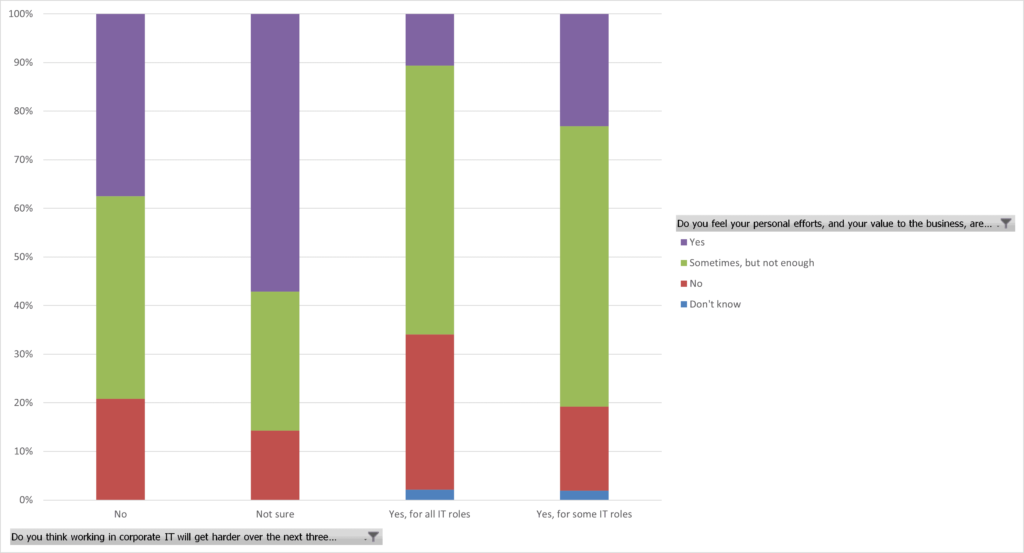
Another correlation (in Q2 and Q4) that could be expected is where respondents who “feel that working in IT is adversely affecting their personal well-being” also don’t think that their “personal efforts, and value to the business, are sufficiently recognized by management.” This was previously highlighted in our 2019 Future of ITSM Survey article. Conversely, where personal efforts are recognized, there are less likely to be well-being issues reported.
It also seems sensible that where an organization is thought to have suitable mechanisms for preventing and helping with well-being issues there’s less likely to be well-being issues (Q7 and Q4). This is shown in the chart below but, as outlined later, we can’t overlook the fact that this could be influenced by those respondents that haven’t suffered from well-being issues automatically stating that their organization’s mechanisms for dealing with well-being issues in ITSM and elsewhere are good (and, of course, they could be right).
Q7 and Q4
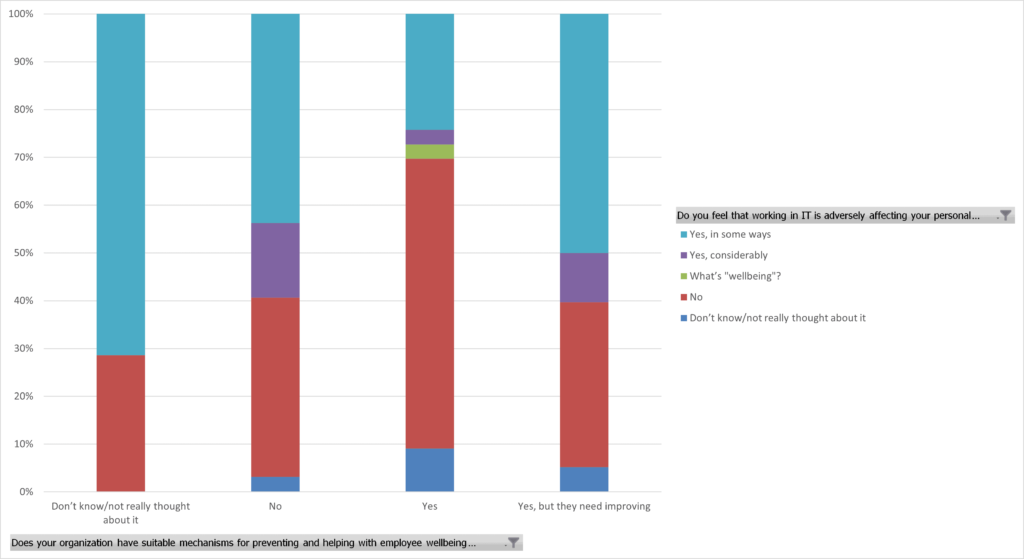
Finally, the chart below (Q1 and Q4) shows something that isn’t immediately obvious but is “obvious with hindsight.” That respondents who don’t feel that working in IT is adversely affecting their well-being (the large red “no” block) nearly make up the full vote for working in IT not getting harder over the next three years. It would be dangerous to make uninformed judgments as to why this is. But we can state that respondents who have been affected by well-being issues are likely to think that working in IT is going to get harder. Plus, those with considerable well-being issues are most likely to think that working in IT is going to get harder for all roles.
Q1 and Q4
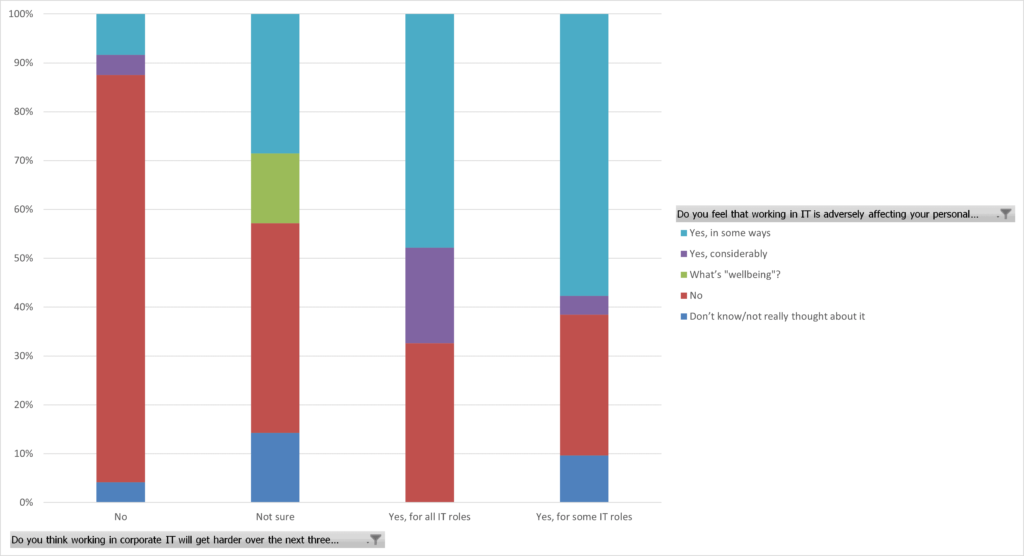
The “less obvious” correlations
The first unexpected correlation (based on Q2 and Q3) is that the employees who don’t feel valued per se also didn’t feel valued during the COVID-19 crisis. Which goes against the commonly held thinking that IT employees felt more recognized and valued during the crisis. This might be caused by the survey questioning – with the generic “personal efforts, and your value to the business, are sufficiently recognized by management” question (Q2) appearing before the “personal efforts were sufficiently recognized by management during the COVID-19 crisis” question (Q3). Such that answering Q2 in the negative then adversely influenced the response to Q3. The flipside of this is that those employees who do feel recognized for their efforts, in the main, also felt recognized during the crisis – the purple blocks in the chart below.
An @ITSM_tools survey finds that employees who don’t feel valued per se also didn’t feel valued during the #COVID19 crisis. Which goes against the commonly held thinking that IT employees felt more recognized and valued during the… Click To TweetQ2 and Q3
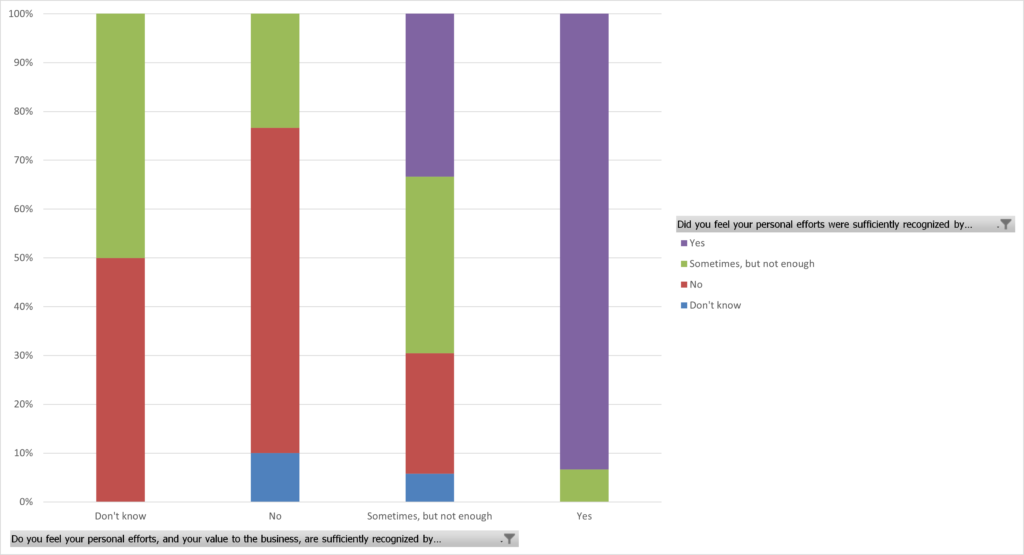
Following on from this (and looking at Q6 and Q3), respondents who don’t feel that they received personal recognition during the crisis are also more likely to think that their immediate manager lacks suitable skills for identifying and dealing with well-being issues in ITSM or elsewhere within IT. And, conversely, nearly all the respondents who reported that their personal efforts were recognized during the crisis think that their immediate manager is suitably skilled to identify and deal with well-being issues – the long purple block in the chart below. Which, given the aforementioned link between recognition and well-being, raises the question of given that these respondents have potentially never needed to invoke any well-being support if they truly know the well-being capabilities of their line managers and organization as a whole.
Q6 and Q3
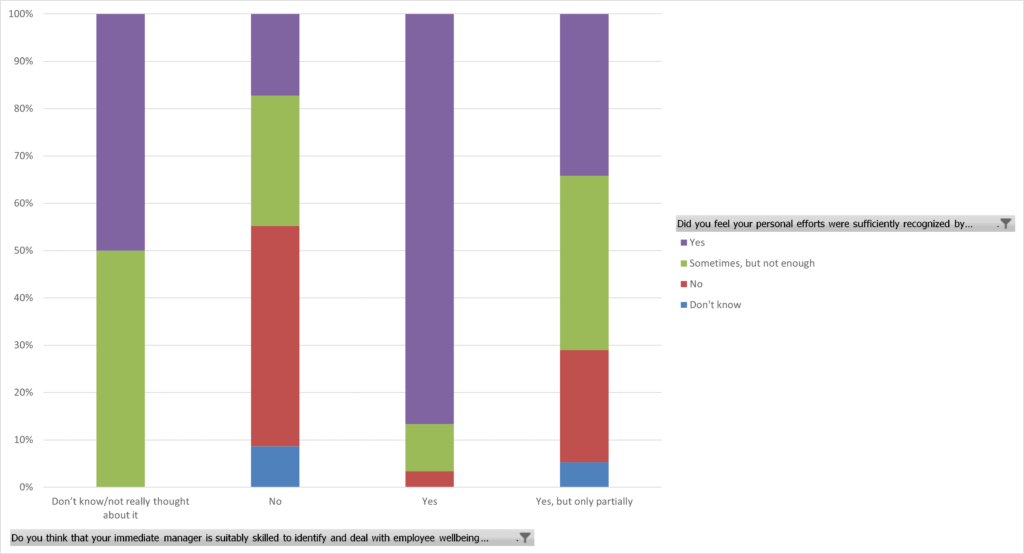
This can again be seen in the link between people not having well-being issues during the crisis and the view that their immediate line manager is fully skilled to identify and deal with employee well-being issues (Q5 and Q6, the green blocks in the chart below). Of course, the linkages here are more complex than simply that the respondents haven’t needed to test the available well-being support.
This is potentially a “chicken and egg”-type situation. Does the lack of well-being issues mean that the managers’ skills can be assumed to be good? Or perhaps the managers’ skills are evident and have actively minimized well-being issue levels? Or, flipping this, are the reported well-being issues in ITSM contributed to or exacerbated by the lack of line manager capabilities? Unfortunately, a conclusion can’t be drawn with the available data.
Q5 and Q6

Another “less obvious” correlation is that perceptions of line manager skills for identifying and dealing with well-being issues are strongly linked to the organizational mechanisms for dealing with well-being issues (Q6 and Q7). This is shown in the chart below, where when a line manager is considered to be suitably skilled the organizational mechanisms are considered suitable too (with or without improvement needs). The purple and green blocks on the right half of the chart show this. Conversely, where organizational mechanisms are seen as unsuitable (the “no” answers, the red blocks) it maps in the main to where immediate managers are perceived as lacking the required skills.
An @ITSM_tools survey finds that employees who say that the #COVID19 crisis hasn’t adversely affected their #wellbeing are more likely to continue to stay working at home (and less likely to prefer being in the office). Click To TweetThis might be a “collective vote” – all “yes” or all “no” – but we can’t discount that these results might be influenced by each element affecting the other – that managers are let down by the organizational mechanisms, or the organizational mechanisms are assumed to be poor where a line manager is not suitably skilled. As with some of the other results, there’s a lot of connective tissue between well-being issues in ITSM and the contributing factors.
Q6 and Q7
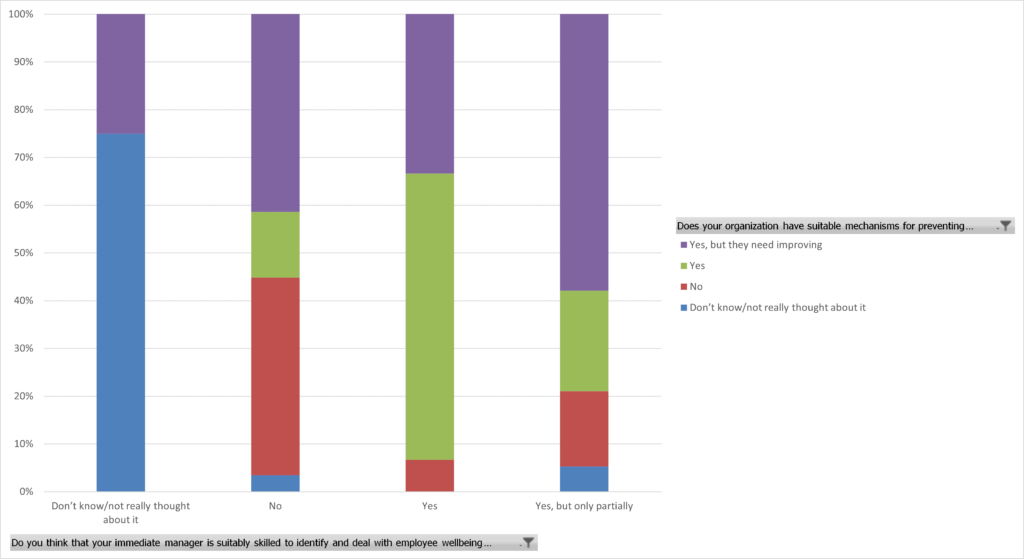
Homeworking and well-being issues in ITSM
I thought it worth separating these findings, particularly because homeworking – or simply being “trapped” at home – has been called out as a “ticking timebomb” in terms of employee well-being.
There are some positive findings though. Those employees that prefer homeworking and can continue working at home are more likely to:
- Feel that their efforts are recognized by management (both pre and during the COVID-19 crisis). Worryingly, those who think that their efforts weren’t recognized during the crisis are more likely to be brought back into the office despite preferring working at home – it might be a bold thing to say but this is increasingly looking like a “management thing” rather than simply a “well-being thing.”
- Think that their immediate manager is suitably skilled to identify and deal with well-being issues.
- Think more highly of their organization’s mechanisms for preventing and handling wellbeing issues – which is interesting given the very valid concerns around homeworking and wellbeing issues.
Finally, those who say that the crisis hasn’t adversely affected their well-being are more likely to continue to stay working at home (and less likely to prefer being in the office). Unsurprisingly, those adversely affected (by the crisis) prefer working in the office.
I hope the above has offered greater insight into the current state of well-being within ITSM and some of the factors affecting both positive and negative well-being. What do you think I missed or got wrong? Or what would you “+1”? Please let me know in the comments section below.
Do you want to read about the software request process?
Stephen Mann
Principal Analyst and Content Director at the ITSM-focused industry analyst firm ITSM.tools. Also an independent IT and IT service management marketing content creator, and a frequent blogger, writer, and presenter on the challenges and opportunities for IT service management professionals.
Previously held positions in IT research and analysis (at IT industry analyst firms Ovum and Forrester and the UK Post Office), IT service management consultancy, enterprise IT service desk and IT service management, IT asset management, innovation and creativity facilitation, project management, finance consultancy, internal audit, and product marketing for a SaaS IT service management technology vendor.

